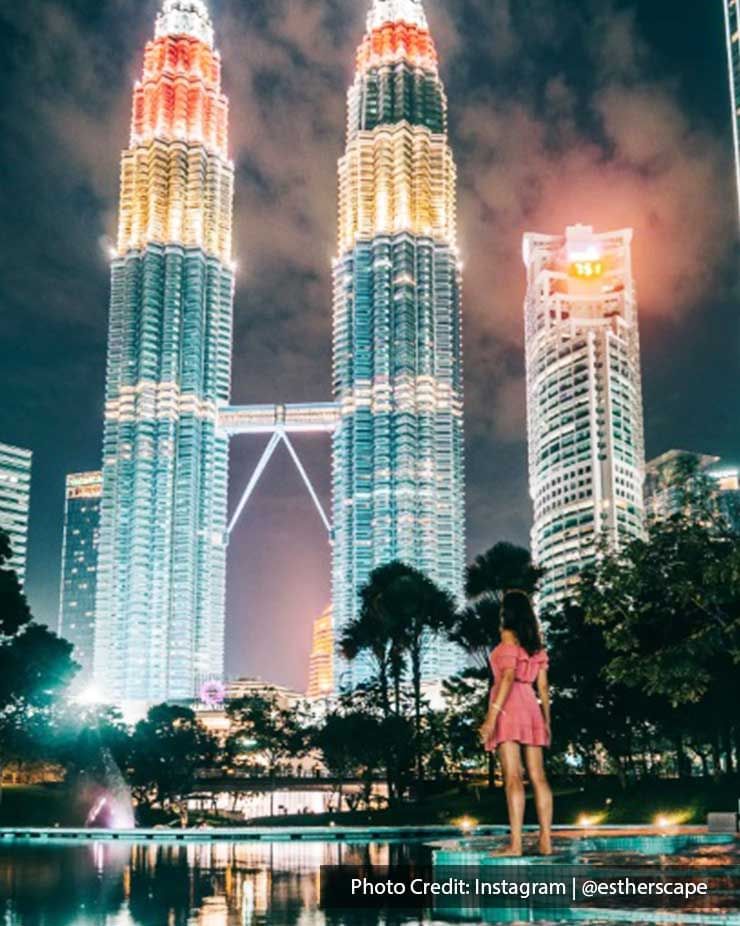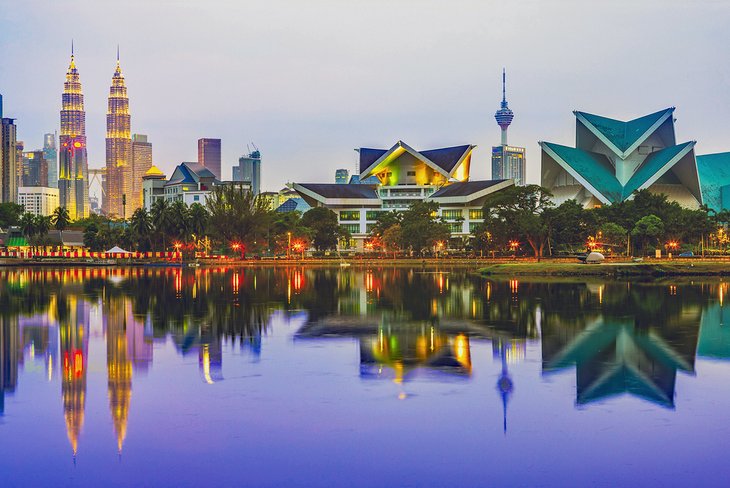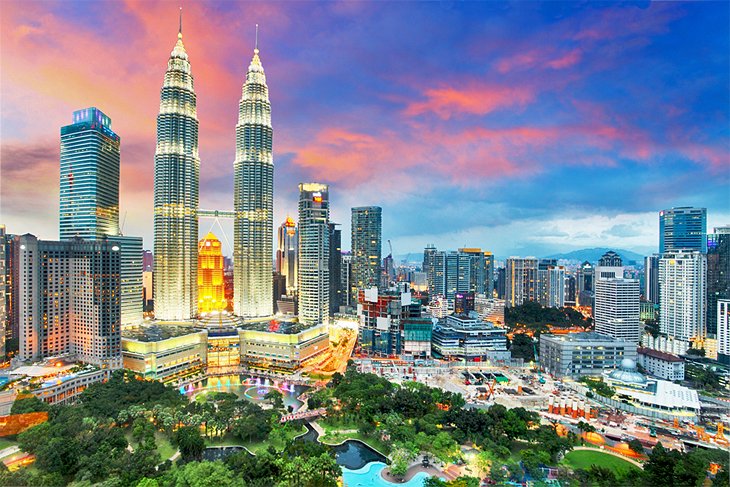
Kuala Lumpur, or KL as it’s affectionately known, is more than just Malaysia’s capital city; it’s a vibrant tapestry woven with threads of rich history, diverse cultures, and futuristic ambition. From the shimmering spires of the Petronas Twin Towers piercing the skyline to the ancient, sacred caves echoing with Hindu devotion, KL offers an exhilarating journey for every traveller. It’s a city that buzzes with energy, tantalizes with exotic flavours, and enchants with its unique blend of tradition and modernity. This comprehensive guide will take you through KL’s unmissable attractions, delve into its fascinating past, equip you with essential travel tips, and help you navigate its bustling streets, ensuring an unforgettable Malaysian adventure.
Top Attractions: Icons, Culture, and Nature
Kuala Lumpur’s cityscape is dotted with landmarks that tell tales of its journey from a humble mining town to a global metropolis. Each attraction offers a distinct flavour of the city, promising a rich and varied experience.

Related Articles about Kuala Lumpur: A Metropolis Where History Meets the Future:
- Japan: A Tapestry of Tradition and Tomorrow – Your Ultimate Guide to Exploration
- Morocco: A Tapestry of Enchantment – Unveiling its Top Attractions and Essential Travel Guide
- The American Tapestry: A Comprehensive Travel Guide to the United States
- Krabi: A Limestone Legacy Where Luxury Meets Paradise
- The Heart of Africa: An Unforgettable Journey Through Kenya
1. Petronas Twin Towers & KLCC Park: No visit to Kuala Lumpur is complete without witnessing the majestic Petronas Twin Towers. Once the tallest buildings in the world, these iconic 88-story structures remain a symbol of Malaysia’s economic prowess and architectural ambition. Visitors can ascend to the Skybridge on the 41st floor or the Observation Deck on the 86th floor for breathtaking panoramic views of the city. At their base lies Suria KLCC, a premier shopping mall, and the beautifully landscaped KLCC Park. This urban oasis features a children’s playground, wading pool, jogging track, and the enchanting Symphony Lake, where a daily light and sound fountain show captivates onlookers. Adjacent to the park is Aquaria KLCC, a state-of-the-art oceanarium showcasing over 5,000 marine and land creatures.
2. KL Tower (Menara KL): Standing tall at 421 metres, the KL Tower offers another perspective of Kuala Lumpur’s sprawling landscape. While slightly shorter than the Petronas Towers, its higher observation deck provides an unobstructed 360-degree view, often preferred by photographers. Beyond the views, the tower complex includes a revolving restaurant (Atmosphere 360), a mini zoo, an F1 simulator, and a cultural village, making it an entertainment hub.
3. Batu Caves: Just a short drive north of the city centre, the Batu Caves are a magnificent limestone hill comprising three main caves and several smaller ones. This sacred Hindu shrine is marked by the colossal golden statue of Lord Murugan, standing at 42.7 metres, guarding the entrance. Visitors must climb 272 vibrant steps to reach the main Temple Cave, where intricate Hindu deities and murals adorn the walls. Expect to encounter mischievous monkeys along the ascent, but be wary of your belongings. The caves are particularly vibrant during the annual Thaipusam festival.
4. Central Market (Pasar Seni): A designated heritage site, Central Market, built in 1888, was once a wet market but has been transformed into a vibrant cultural centre. It’s the perfect place to shop for authentic Malaysian handicrafts, souvenirs, textiles, and art. The market is divided into zones reflecting Malaysia’s diverse ethnic groups – Malay, Chinese, and Indian – offering unique products from each. Beyond shopping, you can enjoy cultural performances and indulge in local delicacies at its food court.
5. Chinatown (Petaling Street): Immerse yourself in the bustling energy of Chinatown, centred around Petaling Street. This vibrant street market is a treasure trove of bargain goods, from clothes and accessories to electronics and souvenirs. More importantly, it’s a paradise for foodies, offering an array of hawker stalls serving up delicious local street food like Hokkien Mee, Assam Laksa, and roasted duck. Don’t miss the stunning Sri Mahamariamman Temple, KL’s oldest Hindu temple, and the ornate Chan See Shu Yuen Temple nearby.
6. Little India (Brickfields): Just southwest of the city centre, Brickfields transforms into a kaleidoscope of colours and sounds, aptly named Little India. The streets are lined with shops selling vibrant sarees, traditional Indian attire, intricate gold jewellery, and fragrant spices. The aroma of Indian cuisine fills the air, inviting you to sample banana leaf rice, dosai, and various curries. It’s a lively cultural enclave, especially during festivals like Deepavali.
7. Merdeka Square & Sultan Abdul Samed Building: Merdeka Square (Independence Square) holds immense historical significance as the place where the Malaysian flag was first hoisted in 1957, marking the nation’s independence from British rule. The square is surrounded by stunning colonial-era buildings, most notably the Sultan Abdul Samed Building with its distinctive Moorish architecture and magnificent clock tower. It’s a picturesque area perfect for a stroll and a glimpse into KL’s colonial past.
8. The National Mosque (Masjid Negara): An architectural marvel, the National Mosque of Malaysia is a symbol of Islamic art and a testament to modern Islamic design. Its unique folded-plate roof, resembling an open umbrella, and 73-metre high minaret can accommodate 15,000 worshippers. Visitors are welcome outside of prayer times, and modest attire is required (robes are provided). The serene atmosphere and beautiful gardens offer a peaceful escape from the city’s hustle.
9. Islamic Arts Museum Malaysia: Located near the National Mosque, this museum houses Southeast Asia’s largest collection of Islamic art. Its impressive dome and intricate tile work are a sight to behold, while inside, you’ll find exquisite artefacts, textiles, jewellery, and manuscripts from across the Islamic world. It’s an enriching experience for those interested in art, history, and culture.

10. Perdana Botanical Garden (Lake Gardens): Escape the urban sprawl in the sprawling Perdana Botanical Garden, KL’s oldest and largest park. This green lung offers a refreshing respite with beautifully landscaped gardens, walking trails, and several mini-attractions within its bounds. Highlights include the KL Bird Park (the world’s largest free-flight aviary), the Butterfly Park, Deer Park, and the Orchid and Hibiscus Gardens. It’s a perfect spot for nature lovers and families.
11. KL Forest Eco Park (Bukit Nanas Forest Reserve): One of the oldest permanent forest reserves in Malaysia, this urban jungle offers a unique opportunity to experience a rainforest within the city limits. Its canopy walk provides thrilling views of the trees and city skyline, allowing visitors to appreciate Malaysia’s rich biodiversity.
A Glimpse into Kuala Lumpur’s History
Kuala Lumpur’s story is one of rapid transformation. Its humble beginnings trace back to the 1850s when a group of Chinese tin miners settled at the confluence of the Gombak and Klang rivers – a "muddy confluence," which is the literal translation of Kuala Lumpur. The arduous work of tin mining attracted more settlers, including Malay and Indian labourers, laying the foundation for its multicultural fabric.
The British colonial era, beginning in the late 19th century, brought significant development. Frank Swettenham, a British Resident, played a pivotal role in planning and modernising the town, introducing brick buildings, railways, and proper infrastructure. Buildings like the Sultan Abdul Samed Building and the Old Railway Station stand as magnificent reminders of this period.
After enduring Japanese occupation during World War II, Malaysia gained independence from British rule on August 31, 1957, with the historic declaration taking place at Merdeka Square. Since then, Kuala Lumpur has undergone phenomenal growth, evolving from a tin-mining outpost into a bustling global metropolis, a financial hub, and a cultural melting pot, all while retaining its unique heritage.
Navigating Kuala Lumpur: Transportation
Getting around Kuala Lumpur is surprisingly easy and efficient, thanks to its well-developed transportation network.
- Public Transport: KL boasts an excellent integrated public transport system. The LRT (Light Rail Transit), MRT (Mass Rapid Transit), and Monorail lines connect most major attractions and commercial centres. Purchase a Touch ‘n Go card for seamless travel, or buy single-journey tokens at stations.
- Grab: This ride-hailing app is ubiquitous and incredibly popular. It offers convenient, affordable, and fixed-price rides, often cheaper and more reliable than traditional taxis. Download the app before you arrive.
- Buses: RapidKL buses cover an extensive network, reaching areas not served by the rail lines. While affordable, they can be a bit challenging for first-time visitors to navigate due to traffic and complex routes.
- Taxis: Metered taxis are available, but ensure the driver uses the meter. Many drivers may try to negotiate a fixed fare, which is often higher than the metered rate or Grab.
- KL Hop-On Hop-Off Bus: A convenient option for tourists, this double-decker bus stops at over 20 key attractions, allowing you to explore at your own pace.
- Walking: While possible in specific areas like Bukit Bintang or KLCC, the heat, humidity, and sometimes uneven pavements can make long walks challenging.
Accommodation Options
Kuala Lumpur offers a vast array of accommodation, catering to every budget and preference, from luxurious five-star hotels to charming boutique guesthouses and budget-friendly hostels.
- Luxury (RM 500+): For an indulgent stay, focus on the KLCC and Bukit Bintang areas. Hotels like the Mandarin Oriental, Grand Hyatt, EQ Kuala Lumpur, and The St. Regis offer impeccable service, world-class amenities, and often stunning views of the Petronas Twin Towers.
- Mid-Range (RM 200-500): Bukit Bintang, Pudu, and Chow Kit are excellent choices for comfortable stays without breaking the bank. Options like Impiana KLCC Hotel, Novotel Kuala Lumpur City Centre, and CitizenM Kuala Lumpur Bukit Bintang provide great value, modern facilities, and good connectivity.
- Budget (Under RM 200): Chinatown, Pudu, and parts of Bukit Bintang are home to numerous hostels and budget hotels. Reggae Mansion Kuala Lumpur and BackHome Kuala Lumpur are popular hostel choices known for their social atmosphere and good facilities. Many guesthouses offer clean, basic rooms perfect for backpackers.
- Boutique/Unique: For a more distinctive experience, consider boutique hotels like The Chow Kit – An Ormond Hotel or Else Kuala Lumpur, which offer stylish designs and a unique local flavour.
- Serviced Apartments: Ideal for longer stays or families, serviced apartments offer more space and amenities like kitchens and laundry facilities.
When choosing accommodation, consider its proximity to public transport stations (LRT/MRT/Monorail) to easily access attractions.
Travel Tips for a Seamless Experience
To make the most of your Kuala Lumpur adventure, keep these practical tips in mind:
- Currency: The local currency is the Malaysian Ringgit (MYR). ATMs are widely available, and credit cards are accepted in most establishments.
- Language: Bahasa Malaysia (Malay) is the official language, but English is widely spoken, especially in tourist areas, hotels, and restaurants.
- Dress Code: While KL is a modern city, it’s respectful to dress modestly, especially when visiting religious sites. Shoulders and knees should be covered. Lightweight, breathable fabrics are best due to the climate.
- Weather: Kuala Lumpur experiences a tropical rainforest climate – hot and humid year-round, with average temperatures around 27-33°C. Expect occasional heavy downpours, especially in the afternoons. Always carry an umbrella or rain jacket.
- Safety: KL is generally safe for tourists, but like any big city, be aware of your surroundings. Guard against pickpockets in crowded markets (like Petaling Street) and on public transport. Be cautious of common scams.
- Food Hygiene: Embrace the street food scene, but choose stalls with a high turnover of customers – a good sign of freshness. Tap water is generally safe to drink, but bottled water is recommended.
- Connectivity: Purchasing a local SIM card (e.g., Celcom, Maxis, Digi) upon arrival is affordable and provides easy access to data for navigation and communication. Free Wi-Fi is available in many hotels, cafes, and malls.
- Tipping: Tipping is not customary in Malaysia, as a service charge is often included in restaurant bills. However, a small tip for excellent service is always appreciated.
- Hydration: Drink plenty of water throughout the day to stay hydrated in the humid climate.
- Bargaining: Bargaining is common and expected in markets like Petaling Street and Central Market. Start at about half the asking price and negotiate politely.
Best Time to Visit
Kuala Lumpur is a year-round destination due to its equatorial climate, but certain periods offer slightly more favourable conditions.
- Dryer Months (May to July & December to February): These periods generally experience less rainfall and more sunshine, making them ideal for outdoor activities and sightseeing. However, they also coincide with peak tourist seasons, so expect larger crowds and potentially higher prices for flights and accommodation.
- Shoulder Seasons (March-April & August-November): While these months might see slightly more rain, the showers are often short, heavy bursts, typically in the late afternoon, leaving plenty of time for exploration. Travel during these periods can also offer better value for flights and hotels and fewer crowds.
- Avoid Major Public Holidays: If you dislike crowds, try to avoid visiting during major public holidays like Chinese New Year (usually Jan/Feb) and Hari Raya Aidilfitri (dates vary based on the Islamic calendar), as the city can get extremely busy and some businesses might be closed.
Ultimately, KL’s vibrant energy and indoor attractions mean that even during the rainy season, there’s always plenty to see and do. Just be prepared for the occasional downpour!
Conclusion
Kuala Lumpur is a city that never fails to impress. It’s a dynamic fusion of cultures, a culinary hotspot, and a testament to Malaysia’s rapid growth, all while holding onto its rich heritage. From the towering architectural marvels to the spiritual sanctuaries, the bustling markets to the serene green spaces, KL offers an experience as diverse as its population. With its efficient transportation, varied accommodation, and warm hospitality, exploring this magnificent city is an accessible and immensely rewarding adventure. Embark on your journey to Kuala Lumpur, and prepare to be captivated by its unique charm and unforgettable experiences.





